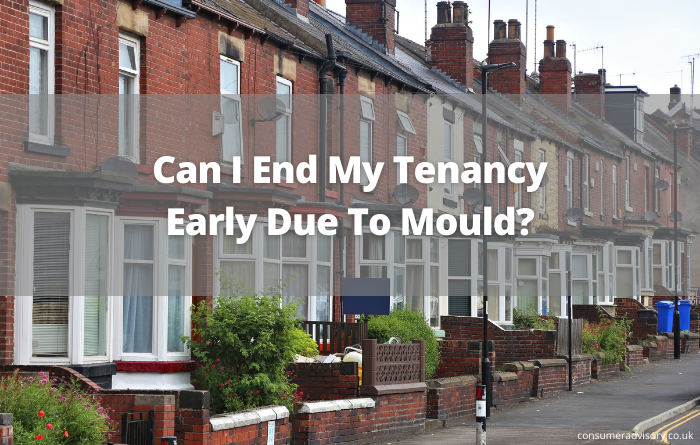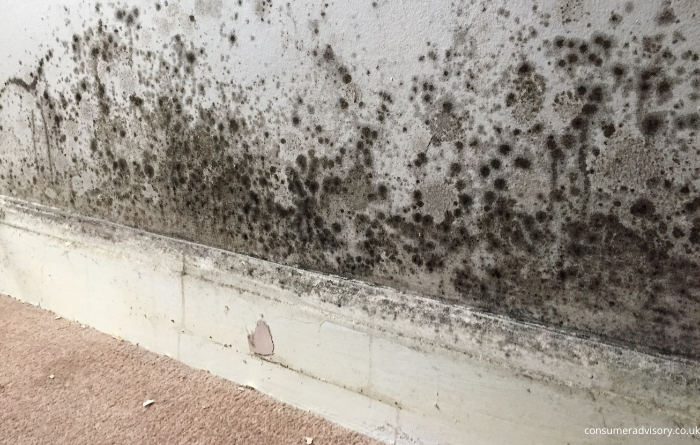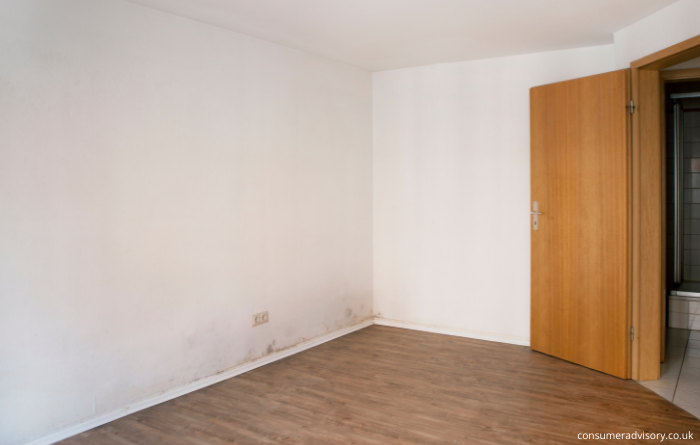
If you’re suffering from mould in your rental property and your landlord is not taking steps to resolve the issue, you may be left asking the question ‘can I end my tenancy early due to mould?’. The answer to this question depends on whether there is a break clause in your tenancy agreement. If your tenancy agreement contains a break clause, you may be able to terminate your tenancy early. If your tenancy does not contain a break clause, there are still steps that you can take to resolve the issue, so don’t panic.
For example, if your landlord is refusing to remove the mould and treat the issue, you can contact your local authority. They will perform an inspection to determine whether your landlord is acting negligently by refusing to treat the mould issue. If they are found to be negligent, the local authority will present the landlord with an order to carry out the required repairs.
In this article, we’ll explore the issue of mould in a rental property in more detail, discussing the responsibilities of your landlord, as well as ways that you can help to reduce the risk of mould becoming a problem in your property.
What Causes Mould In A Property?
Mould is a type of fungus that can grow in damp conditions. It’s often found in areas of high humidity, such as bathrooms and kitchens. Mould can also grow on clothing, leather goods, and paper products.
Mould needs four things to grow:
– A food source (mould feeds on organic matter, such as dust, dirt, or paint)
– Moisture
– Warmth
– A lack of air circulation
Mould can cause a range of health problems, including respiratory problems, skin irritation, and allergies. If you’re concerned that you or your family are being affected by mould in your property, it’s important to seek medical advice.
Types Of Mould
There are a few different types of damp that you might experience in your property. The most common types are:
– Condensation: Caused by water vapour in the air, which comes into contact with a cold surface (such as a window) and turns into water droplets.
– Rising damp: Caused by groundwater that rises up through the walls of your property.
– Penetrating damp: Caused by water leaking in from outside the property.
– Capillary action: Caused by moisture being drawn up through small pores or cracks in the walls or floors of your property.

How Can I Tell If There Is Mould In My Property?
If you’re concerned that there may be mould in your property, there are a few signs that you can look out for:
– Discoloration on walls, ceilings, or floors
– A musty smell
– Peeling or flaking paint
– Condensation on windows
– Damaged or rotting wood
If you notice any of these signs, it’s important to investigate further. The best way to check for mould is to use a damp meter. You can buy one of these from most hardware stores, or you can hire one from a professional company. You can also pay for a professional damp survey to be carried out on your property.
Once you’ve located the mould, it’s important to identify the type of damp that’s causing it. This will help you to determine the best course of action for dealing with the problem.
What Is My Landlord’s Responsibility For Mould In My Property?
Your landlord is responsible for ensuring that your rental property is fit for human habitation. This means that they are required to take steps to prevent mould from becoming a problem in the first place, as well as taking action to resolve any existing mould issues.
Your landlord should:
– Inspect the property for signs of mould and take steps to address any issues found
– Install ventilation in damp areas, such as bathrooms and kitchens
– Regularly check taps, showers, and other water fixtures to ensure that they are not leaking water
If your landlord is not taking steps to address a mould issue in your rental property, you can contact your local authority. They will perform an inspection to determine whether your landlord is acting negligently by refusing to treat the mould issue. If they are found to be negligent, the local authority will present the landlord with an order to carry out the required repairs.
What Are My Rights As A Tenant If There Is Mould In My Property?
If you’re suffering from mould in your rental property, there are a few steps that you can take to try and resolve the issue.
– Contact your landlord and let them know about the problem
– If your landlord is not taking steps to address the issue, contact your local authority
– Keep a diary of any health problems that you or your family are experiencing as a result of the mould
– Take photographs of the mould to document the problem
If you’re unable to resolve the issue with your landlord, you may be able to terminate your tenancy early. However, this depends on whether your tenancy agreement contains a break clause. If it does, you may be able to terminate your tenancy without penalty.

Can I Withhold Rent For Mould?
If you’re experiencing mould in your rental property, you may be tempted to withhold rent. However, this is not advisable. If you withhold rent, you could be evicted from the property and may lose some or all of your deposit.
If you’re having trouble resolving a mould issue with your landlord, it’s best to seek professional advice. A solicitor or housing advisor will be able to advise you on the best course of action to take, as well as help you to understand your rights and responsibilities.
Can A Landlord Deduct Deposit For Mould?
A landlord can deduct money from a tenant‘s deposit to cover the cost of repairing damage caused by the tenant. This includes damage caused by mould. However, the landlord cannot deduct money for the cost of treating mould that is not the tenant’s fault.
So, the landlord will first need to prove that the mould has been caused by the negligence of the tenant if they want to take money from your deposit to cover mould damage.
How To Avoid Mould In A Property
There are a few simple steps that you can take to help prevent mould from forming in your property.
- Keep the property clean and free of clutter
- Vacuum and dust regularly
- Open your windows regularly to allow fresh air to circulate
- Inspect taps, showers, and other water fixtures for leaks
- Install ventilation in damp areas, such as bathrooms and kitchens
- Repair any damage to the property that could lead to moisture build-up
- Contact your landlord at the first sign of mould in the property
Is Mould The Tenant’s Fault?
Mould can be caused by a number of different factors. In some cases, it may be the tenant’s fault. For example, if the tenant doesn’t keep the property clean or fails to repair any damage that could lead to moisture build-up, they may be held responsible for mould growth.
In other cases, however, mould may be the landlord’s responsibility. For example, if the property is not adequately ventilated or if there are leaks in fixtures and fittings, the landlord may be held liable.

Should I Tell My Landlord About Mould?
If you’re experiencing mould in your rental property, you should contact your landlord as soon as possible. This is because if mould is dealt with as early as possible, it may be possible to prevent it from becoming a bigger problem that is harder to fix.
If the landlord is not taking steps to address the problem, you may need to contact your local authority. They will be able to investigate the problem and may be able to take enforcement action against the landlord if they find that the property is not up to a satisfactory standard.
You should also keep a diary of any health problems that you or your family are experiencing as a result of the mould. This will be helpful if you need to take legal action against your landlord at a later date.
Who Is Responsible For Damp In A Rental Property?
The tenant and the landlord are both responsible for damp in a rental property. The tenant is responsible for keeping the property clean and free of clutter, while the landlord is responsible for repairing any damage that could lead to moisture build-up. If the property is not adequately ventilated, the landlord may also be held liable for mould growth.
If you’re experiencing damp or mould in your rental property, you should contact your landlord as early as possible. The sooner the problem is identified, the easier it may be to resolve.
What Are Symptoms Of Mould Exposure?
If you’re exposed to mould for a long period of time, it can cause a number of health problems. Some of the most common symptoms of mould exposure include:
- Sinus infections
- Coughing and wheezing
- Itchy skin
- Red, watery eyes
- Asthma attacks
- Bronchitis
If you’re experiencing any of these symptoms, you should see a doctor as soon as possible. You should also contact your landlord to let them know about the problem.
How Much Compensation Can I Get For Damp And Mould?
If you’re experiencing damp or mould in your rental property, you may be able to get compensation from your landlord. This compensation can cover the cost of fixing the problem, as well as any health problems that have been caused by the mould.
However, the amount of compensation that you can get will depend on the individual circumstances of your case. You should contact a lawyer to find out more about your rights and how much compensation you could be entitled to.
How Long Do Landlords Have To Fix Problems?
Landlords have a certain amount of time to fix problems in their rental property. This is known as the ‘repairing standard’.
The repairing standard sets out the minimum repairs that a landlord must carry out in order to make sure that a property is safe and fit for habitation.
If your landlord is not fixing a problem that is causing damp or mould, you may need to contact your local authority. They will be able to investigate the problem and may be able to take enforcement action against the landlord if they find that the property is not up to a satisfactory standard.
In Summary
Damp and mould are common issues, especially in older houses. If you are experiencing mould in your rental property that is caused by poor ventilation or a structural issue in the property, your landlord has an obligation to resolve the issue.
If your landlord refuses to act, this may leave you wondering ‘can I end my tenancy early due to mould?’. Unless there is a break clause in your tenancy agreement, it’s unlikely that you’ll be able to end your tenancy early, and you should avoid withholding rental payments. The best course of action in this situation is to contact your local authority for an investigation to be completed.
